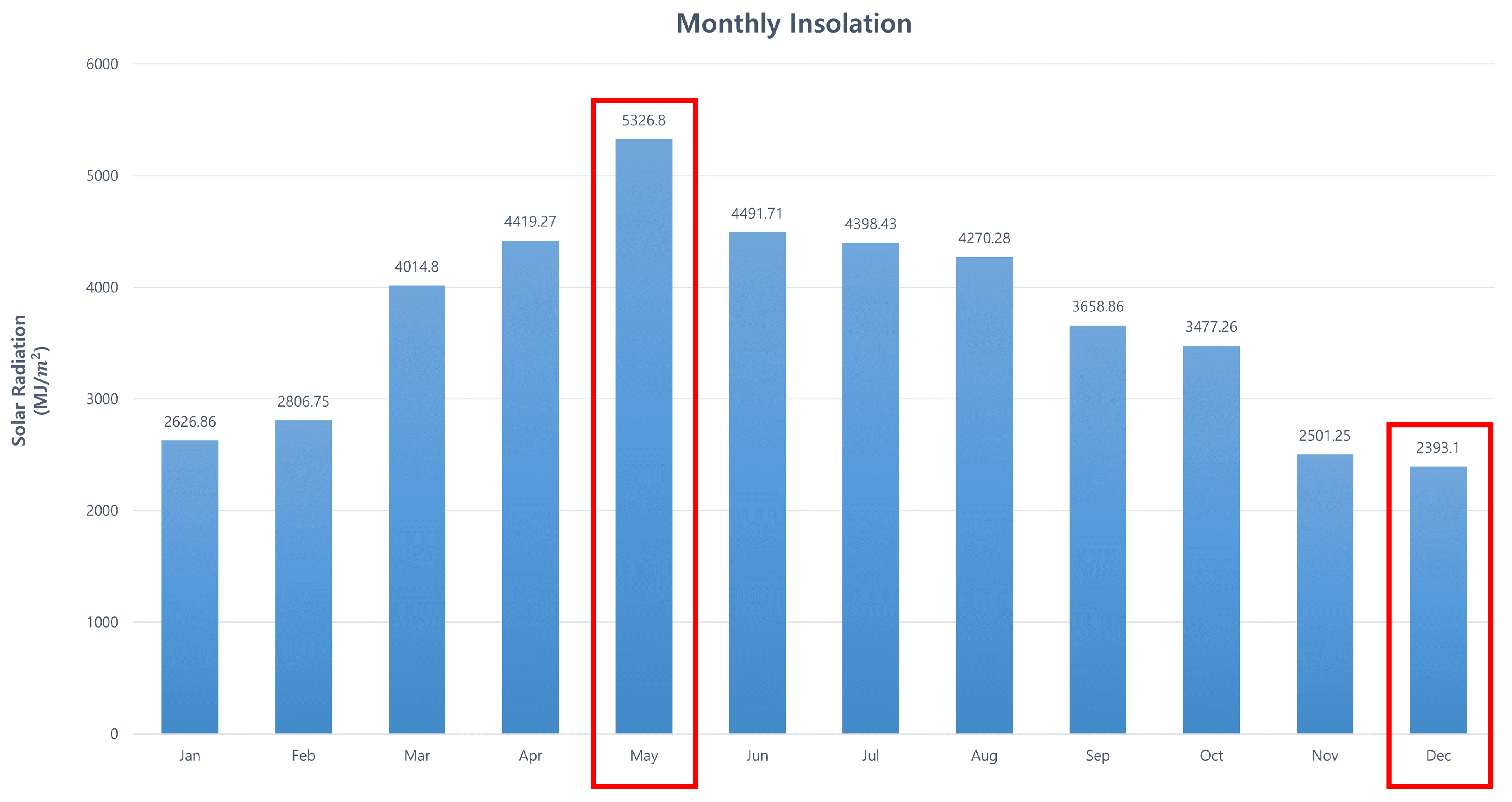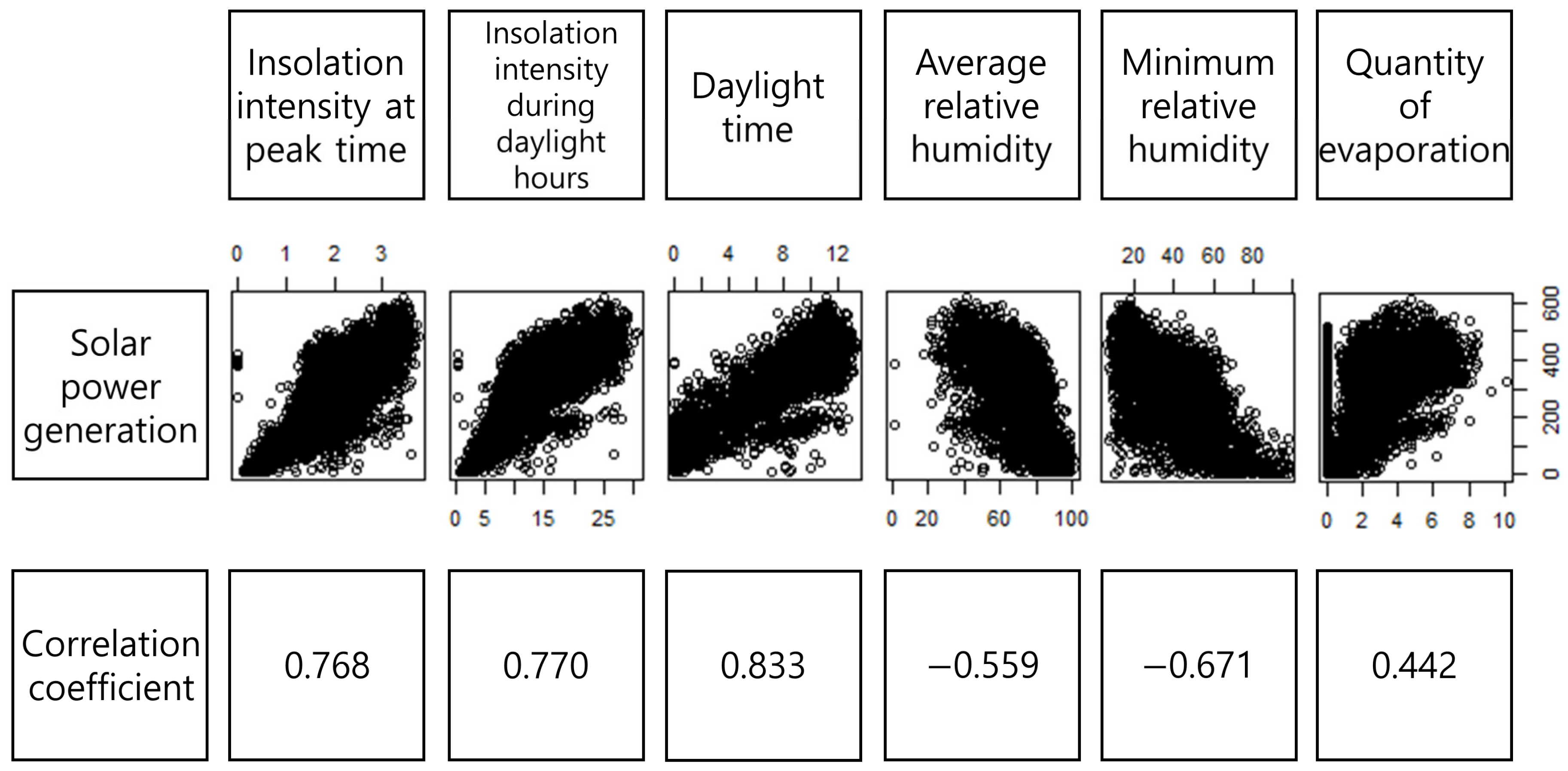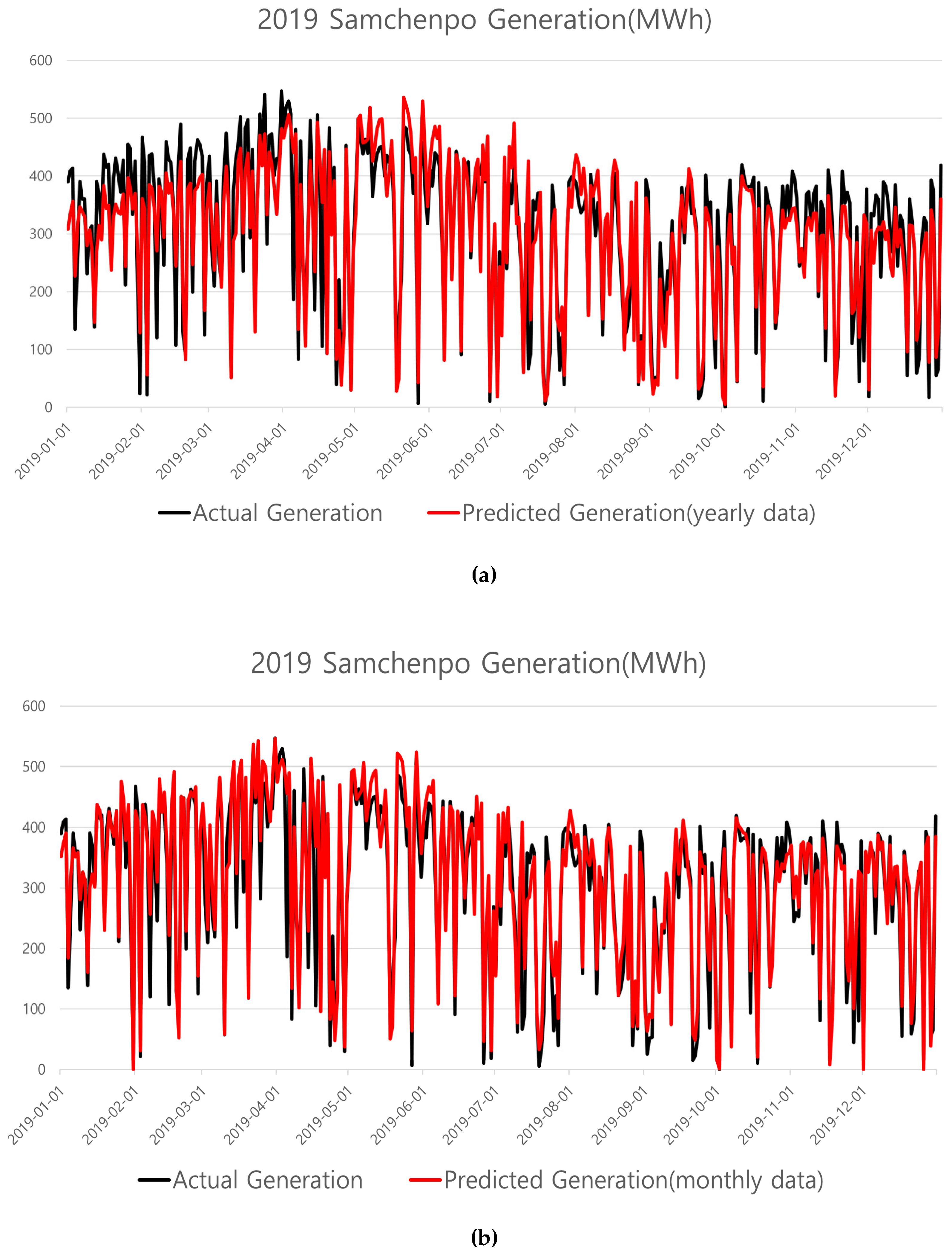Use of a Big Data Analysis in Regression of Solar Power Generation on Meteorological Variables for a Korean Solar Power Plant
Abstract
1. Introduction
2. Data and Processing
2.1. Selection of a Solar Power Plant for Analysis
2.2. Meteorological Data
2.3. Analysis Method
3. Results and Discussion
4. Conclusions
Author Contributions
Funding
Institutional Review Board Statement
Informed Consent Statement
Data Availability Statement
Acknowledgments
Conflicts of Interest
References
- Korea Power Exchange. Power Generation Facility Status in 2019; Korea Power Exchange: Naju, Korea, 2020. [Google Scholar]
- Ministry of Trade, Industry and Energy. Implementation Plan for Renewable Energy 3020; Korea Government: Sejong, Korea, 2017.
- Kim, S.H.; Kim, S.W.; Seong, B.H.; Lee, G.M.; Oh, S.B.; Hwang, C.G. Relation between Module Temperature and Power in the 1 MW Rooftop Photovoltaic Power Plant. Trans. Korean Inst. Elect. Eng. 2014, 12, 154–155. [Google Scholar]
- Korea Meteorological Administration. Weather Resource Analysis Report for Optimal Utilization of Solar Energy; Korea Meteorological Administration: Seoul, Korea, 2008.
- de Freitas Viscondi, G.; Alves-Souza, S.N. A Systematic Literature Review on Big Data for Solar Photovoltaic Electricity Generation Forecasting. Sustain. Energy Technol. Assess. 2019, 31, 54–63. [Google Scholar] [CrossRef]
- Wolff, B.; Lorenz, E.; Kramer, O. Statistical Learning for Short-Term Photovoltaic Power Predictions. Stud. Comput. Intell. 2016, 645, 31–45. [Google Scholar]
- Ruiz-Arias, J.A.; Alsamamra, H.; Tovar-Pescador, J.; Pozo-Vázquez, D. Proposal of a Regressive Model for the Hourly Diffuse Solar Radiation under All Sky Conditions. Energy Convers. Manag. 2010, 51, 881–893. [Google Scholar] [CrossRef]
- Chen, B.; Lin, P.; Lai, Y.; Cheng, S.; Chen, Z.; Wu, L. Very-Short-Term Power Prediction for PV Power Plants Using a Simple and Effective RCC-LSTM Model Based on Short Term Multivariate Historical Datasets. Electronics 2020, 9, 289. [Google Scholar] [CrossRef]
- Benmouiza, K.; Cheknane, A. Small-Scale Solar Radiation Forecasting Using ARMA and Nonlinear Autoregressive Neural Network Models. Theor. Appl. Climatol. 2016, 124, 945–958. [Google Scholar] [CrossRef]
- Hossain, M.S.; Mahmood, H. Short-Term Photovoltaic Power Forecasting Using an LSTM Neural Network and Synthetic Weather Forecast. IEEE Access 2020, 8, 172524–172533. [Google Scholar] [CrossRef]
- Kalogirou, S.A. Artificial Neural Networks in Renewable Energy Systems Applications: A Review. Renew. Sustain. Energy Rev. 2001, 5, 373–401. [Google Scholar] [CrossRef]
- Lee, D.H.; Kim, K.H. Deep Learning Based Prediction Method of Long-term Photovoltaic Power Generation Using Meteorological and Seasonal Information. J. Soc. e-Bus. Stud. 2019, 24, 1–16. [Google Scholar]
- Lee, K.H.; Son, H.G.; Kim, S. A Study on Solar Energy Forecasting Based on Time Series Models. Korean J. Appl. Stat. 2018, 30, 139–153. [Google Scholar]
- Jeong, J.H.; Chae, Y.T. Improvement for Forecasting of Photovoltaic Power Output Using Real Time Weather Data Based on Machine Learning. J. Korean Soc. Living Environ. Sys. 2018, 25, 119–125. [Google Scholar] [CrossRef]
- Johnson, J.W. A Heuristic Method for Estimating the Relative Weight of Predictor Variables in Multiple Regression. Multivar. Behav. Res. 2000, 35, 1–19. [Google Scholar] [CrossRef]
- Muenchen, R.A. The Popularity of Data Analysis Software. R4Stats.Com 2012, No. April. Available online: http://r4stats.com/articles/popularity/ (accessed on 11 February 2021).
- Lee, G.H.; Lee, G.J.; Gang, S.W. Power Plant Location Analysis and Selection for Efficient Solar Energy Production. Korean Energy Econ. Rev. 2018, 17, 53–87. [Google Scholar]
- Jo, D.K.; Kang, Y.H.; Auh, C.M. A Study on the Analysis of Solar Radiation Characteristics on a High Elevated Area. J. Korean Solar Energy Soc. 2003, 23, 23–28. [Google Scholar]
- Korea Southeast Power Co. Ltd. Available online: https://www.koenergy.kr/kosep/hw/gv/nf/nfhw37/main.do?menuCd=GV050201 (accessed on 21 January 2021).
- Korea Central Power Co. Ltd. Available online: https://www.komipo.co.kr/kor/content/36/main.do?mnCd=FN021109 (accessed on 21 January 2021).
- Korea Southern Power Co. Ltd. Available online: https://www.kospo.co.kr/kospo/111/subview.do (accessed on 21 January 2021).
- Korea East-West Power Co. Ltd. Available online: https://ewp.co.kr/kor/subpage/contents.asp?cn=1314FD2O&ln=OO69QUWU&sb=UJ2MZMM2&tb=2ZWNPNL (accessed on 21 January 2021).
- Korea Western Power Co. Ltd. Available online: https://www.iwest.co.kr/iwest/559/subview.do (accessed on 21 January 2021).
- Korea Southeast Power Co. Ltd. Available online: https://www.koenergy.kr/kosep/hw/fr/ov/ovhw25/main.do?menuCd=FN0305010102 (accessed on 21 January 2021).
- Korea Southeast Power Co. Ltd. Available online: https://www.koenergy.kr/kosep/hw/br/sp/sphw04/main.do?menuCd=BR010203 (accessed on 21 January 2021).
- Korea Institute of Energy Research. Solar Energy Data Reference Standard Detailed Evaluation Procedure; Korea Institute of Energy Research: Daejeon, Korea, 2010. [Google Scholar]
- Korea Meteorological Administration. Available online: https://data.kma.go.kr/cmmn/main.do (accessed on 4 February 2021).
- Ministry of Public Administration and Security Information Disclosure System. Available online: https://www.open.go.kr/com/main/mainView.do?mainBgGubun=search (accessed on 4 February 2021).
- Sousa, S.I.V.; Martins, F.G.; Alvim-Ferraz, M.C.M.; Pereira, M.C. Multiple Linear Regression and Artificial Neural Networks Based on Principal Components to Predict Ozone Concentrations. Environ. Model. Softw. 2007, 22, 97–103. [Google Scholar] [CrossRef]
- Kang, S.H. Introductory Statistic; Free Academy Publishing: Paju, Korea, 2012; pp. 456–494. [Google Scholar]
- Kang, H.G. Statistical Methods for Healthcare Research, 6th ed.; Koonja Publishing: Paju, Korea, 2017; pp. 315–344. [Google Scholar]
- David, M.L. Statistics for Managers Using Microsoft Excel, 5th ed.; Pearson Prentice Hall Pulbishing: Upper Saddle River, NJ, USA, 2018; pp. 613–644. [Google Scholar]
- Kim, J.H. Environmental Statistics & Data Analysis; Hannarae Publishing: Seoul, Korea, 2018; pp. 205–269. [Google Scholar]




| Facility Capacity (MegaWatt) | Operation Date | Type | |
|---|---|---|---|
| Samcheonpo #1 | 0.1 | October 2005 | |
| Samcheonpo #2 | 0.99 | April 2010 | |
| Samcheonpo #3 | 0.35 | April 2012 | |
| Samcheonpo #4 | 1.85 | June 2012 | |
| Samcheonpo #5 | 10.587 | June 2017 |
| Coefficient | Std. Error | p-Value | VIF | |
|---|---|---|---|---|
| Constant | 174.97 | 8.48 | - | |
| Insolation intensity at peak time (MJ/m2) | 49.73 | 4.99 | 13.14 | |
| Insolation intensity during daylight hours (MJ/m2) | 4.42 | 0.75 | 18.61 | |
| Daylight time (h) | 13.64 | 0.67 | 4.87 | |
| Average relative humidity (%) | −1.30 | 0.16 | 4.21 | |
| Minimum relative humidity (%) | −0.74 | 0.15 | 6.06 | |
| Quantity of evaporation (kg/h) | −9.00 | 0.87 | 2.24 |
| Coefficient | Std. Error | p-Value | VIF | |
|---|---|---|---|---|
| Constant | 201.91 | 8.16 | - | |
| Insolation intensity during daylight hours (MJ/m2) (X1) | 10.92 | 0.37 | 4.48 | |
| Daylight time (h) (X2) | 12.28 | 0.67 | 4.67 | |
| Average relative humidity (%) (X3) | −1.08 | 0.16 | 4.13 | |
| Minimum relative humidity (%) (X4) | −1.09 | 0.15 | 5.70 | |
| Quantity of evaporation (mm) (X5) | −9.83 | 0.88 | 2.22 |
| R2 | Adjusted R2 | RMSE | Std. Error |
|---|---|---|---|
| 0.7738 | 0.7735 | 69.06 | 69.13 |
| Regression Model | R2 | Adjusted R2 | RMSE | Std. Error | ||||||
|---|---|---|---|---|---|---|---|---|---|---|
| Const | ||||||||||
| January | 55.16 | 28.08 | 12.19 | −1.99 | 1.24 | −17.70 | 0.8985 | 0.8966 | 40.66 | 41.11 |
| February | 94.33 | 14.92 | 21.20 | −1.83 | 0.93 | −4.07 | 0.8697 | 0.8671 | 53.97 | 54.63 |
| March | 104.80 | 9.59 | 21.92 | −0.65 | −0.32 | 0.54 | 0.8916 | 0.8896 | 51.59 | 52.15 |
| April | 138.86 | 9.63 | 15.91 | −0.54 | −0.87 | −3.39 | 0.8767 | 0.8744 | 59.90 | 60.58 |
| May | 104.78 | 9.52 | 12.57 | 0.03 | −0.97 | −1.95 | 0.8142 | 0.8108 | 63.66 | 64.35 |
| June | 128.07 | 9.91 | 5.65 | 0.86 | −2.28 | 1.33 | 0.8300 | 0.8268 | 54.93 | 55.55 |
| July | −102.3 | 14.76 | 2.32 | 2.76 | −1.61 | −4.70 | 0.7767 | 0.7726 | 60.55 | 61.21 |
| August | −75.50 | 16.51 | −3.60 | 1.96 | −1.23 | 1.98 | 0.7769 | 0.7728 | 55.06 | 55.66 |
| September | −101.8 | 13.42 | 9.88 | 1.61 | −0.25 | −0.32 | 0.7842 | 0.7801 | 62.42 | 63.12 |
| October | 92.74 | 11.01 | 15.23 | −0.40 | −0.70 | −2.49 | 0.7952 | 0.7914 | 61.57 | 62.43 |
| November | 18.84 | 28.62 | 3.35 | −0.12 | −0.35 | −21.75 | 0.74565 | 0.74084 | 64.94 | 65.67 |
| December | −103.5 | 33.67 | 6.04 | 0.32 | 0.38 | −1.28 | 0.7228 | 0.7178 | 68.39 | 69.14 |
Publisher’s Note: MDPI stays neutral with regard to jurisdictional claims in published maps and institutional affiliations. |
© 2021 by the authors. Licensee MDPI, Basel, Switzerland. This article is an open access article distributed under the terms and conditions of the Creative Commons Attribution (CC BY) license (http://creativecommons.org/licenses/by/4.0/).
Share and Cite
Kim, Y.S.; Joo, H.Y.; Kim, J.W.; Jeong, S.Y.; Moon, J.H. Use of a Big Data Analysis in Regression of Solar Power Generation on Meteorological Variables for a Korean Solar Power Plant. Appl. Sci. 2021, 11, 1776. https://doi.org/10.3390/app11041776
Kim YS, Joo HY, Kim JW, Jeong SY, Moon JH. Use of a Big Data Analysis in Regression of Solar Power Generation on Meteorological Variables for a Korean Solar Power Plant. Applied Sciences. 2021; 11(4):1776. https://doi.org/10.3390/app11041776
Chicago/Turabian StyleKim, Young Seo, Han Young Joo, Jae Wook Kim, So Yun Jeong, and Joo Hyun Moon. 2021. "Use of a Big Data Analysis in Regression of Solar Power Generation on Meteorological Variables for a Korean Solar Power Plant" Applied Sciences 11, no. 4: 1776. https://doi.org/10.3390/app11041776
APA StyleKim, Y. S., Joo, H. Y., Kim, J. W., Jeong, S. Y., & Moon, J. H. (2021). Use of a Big Data Analysis in Regression of Solar Power Generation on Meteorological Variables for a Korean Solar Power Plant. Applied Sciences, 11(4), 1776. https://doi.org/10.3390/app11041776







